Welcome to our regularly updated guide to the best lenses for the king of compact full frame cameras – the Sony a7c!
We’ve already got a complete guide to all the smallest lenses for Sony full-frame, if you want to check out just how extensive the choices are.
After all, a small camera deserves a small lens. Otherwise, if you want our recommendations for the best lens for the Sony a7c read on.

The Sony a7c is one of those cameras that will go down in history as a game-changer. In many ways, it’s the first of its kind. A full featured full frame camera in a compact body, smaller than most APS-C cameras.
But, that’s only one part of the equation. The big Sony advantage is that the Sony a7c has the same lens mount as all other alpha mirrorless cameras (Sony E-mount). This means it automatically has the most extensive lens line-up in mirrorless right now.
That is a big deal.
At the end of the day, lenses are what make a system. Lenses are where most of the fun is.
And Sony’s advantage also extends to third-party lenses. Because Sony willingly shares its lens mount protocol with other manufacturers (i.e. other manufacturers don’t need to reverse engineer anything), Sony E mount now boasts of the most extensive choice of lenses from third-party brands such as Tamron, Sigma, Voigtlander and others.
While the Sony a7c may not be the absolute smallest full frame camera out right now (that honor belongs to the Sigma fp and fpL) – none can come close to the lens selection offered by Sony.
Here, we’re going to take a look at specific lenses that will not only match the a7c’s diminutive body, but will also ensure that you take full advantage of the a7c’s real time tracking auto-focus system – the best in class AF system that Sony introduced in 2019, and a feature which is actually missing in other Sony alpha cameras like the Sony a7iii or the Sony a7rIII.
Best lenses for street photography
Sony FE 35mm f/1.8
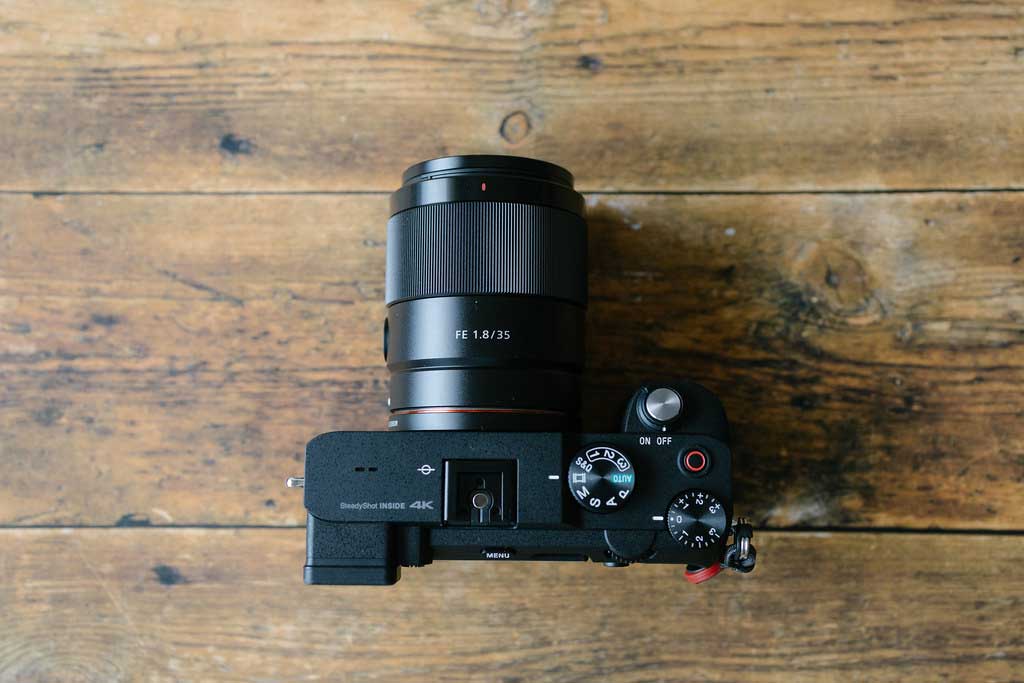
The Sony FE 35mm f/1.8 is the best 35mm lens for most Sony shooters.
Check out my full real world review of this lens here.
Of all the ‘fast’ 35mm options (i.e. f/2 or faster) in Sony full frame E mount, it is the cheapest and lightest.
Despite that, it’s one of the fastest focusing 35mm’s for Sony, it’s sharp, it has the closest MFD, it has a customizable button and it’s weather sealed.
Everything you want in a street lens.
It is also one of the first Sony lens to feature their well dampened manual focus design. It has a near-linear response, and is very useable for manual focus.
It’s a big step up from the likes of the Sony 28mm f/2, for example.
If you’ve used manual focus in other mirrorless lenses, such as Fujifilm’s compact f/2 primes (the Fujicrons) or the Nikon Z 35mm f/1.8 S, for example, you’d know they were a less than acceptable experience.
The Sony is much better in this regard. It still doesn’t beat a real manual focus lens, but it is a huge improvement over other focus-by-wire AF lenses. (In this, the gold standard is the Leica Q, which has the best implementation of manual focus in an AF lens)
You’re spoilt for choice in the 35mm range, but the FE 35 is the one to get for street photography. It’s size and weight alone makes it perfect for carrying around all day, and weaving in and out of crowded sidewalks.
The bright aperture and short minimum focus distance adds some versatility, so you can use it as a general purpose lens as well. E.g. environmental portraits
But, if you don’t care for that, you can get a slower f/2.8 35mm, such as the Sony Zeiss 35mm f/2.8 or the Samyang 35mm f/2.8.
The other option is the Sigma 35mm f/2 DG DN Contemporary lens from their I series range. This one has better haptics, featuring metal build quality and a beautiful aperture ring.
But, it doesn’t focus as close as the Sony and is not weather sealed. While AF is good, it isn’t as fast and decisive as the Sony either.
I find the Sigma to be a better ‘people’ lens – i.e. for portraits and for photographing friends and family – but I find the Sony to be the better street photography or general purpose travel lens.
Important note: Don’t confuse this lens with the Sony 35mm f/1.8 OSS lens, which is a lens designed for crop sensor cameras. It will still work with your a7c, but it will automatically enable APS-C crop mode, giving you a 52mm FOV and only 10 megapixels. Make sure you’re getting the Sony “FE” 35mm f/1.8.
Sony 40mm f/2.5 G
The Sony 40mm f/2.5 G is one of Sony’s initial trio of compact G lens primes that were released at the same time in 2021.
The other two are a 24mm f/2.8 and a 50mm f/2.5. All three lenses share the same size body and same switches and buttons. They are all about the same size as the kit lens for the Sony a7c, the 28-60mm.
While 40mm may be less common than a 35mm or a 50mm, it isn’t a unicorn like some will make you believe.
It’s traditionally been the ‘street’ lens for most systems, as apparently its fairly easy to make a compact 40mm lens.
Some examples include the Panasonic 20mm f/1.7 (equivalent to the field of view of a 40mm, because of the 2x crop factor of micro-four thirds); the Fujifilm 27mm f/2.8 (also equivalent to about 40mm, because of the 1.5x crop factor of Fuji APS-C; the Canon EF 40mm f/2.8 pancake lens for Canon full frame DSLRs, the Pentax 43mm f/1.9 Limited for full frame K-mount, among others.
All of these lenses are “pancake” designs, making them desirable for street photography because of their portability and unobtrusiveness in crowds.
A 40mm is also, supposedly, closer to the angle of view of the human eye than a 50mm.
As for the Sony – it’s easy to see why it earns the G designation. It’s well built, is weather sealed, has a nice aperture ring that can be declicked, and Sony even found the space to add a custom button AND an AF/MF switch.
And, even though it’s almost a pancake lens, Sony somehow managed to throw in not one, but two linear AF motors in there. This automatically propels it above the Sigma 45mm f/2.8 or the Samyang 45mm f/1.8, in terms of AF performance. Even in video, it is fast, smooth and decisive.
While the Sony isn’t a true “pancake” lens, like the other 40mm options for other systems – it does have something that most pancake lenses don’t have – fast AND silent autofocus.
It’s easy to see why the 40 is gaining popularity as a walk-around street photography lens. It gives you the versatility of a wide angle of view, close to that of a 35mm, but also more compression, close to that of a 50mm.
Check the current price of the Sony 40mm f/2.5 on Amazon.
Best zoom lens (standard, walk-around lens)
Sigma 28-70mm f/2.8 DG DN Contemporary
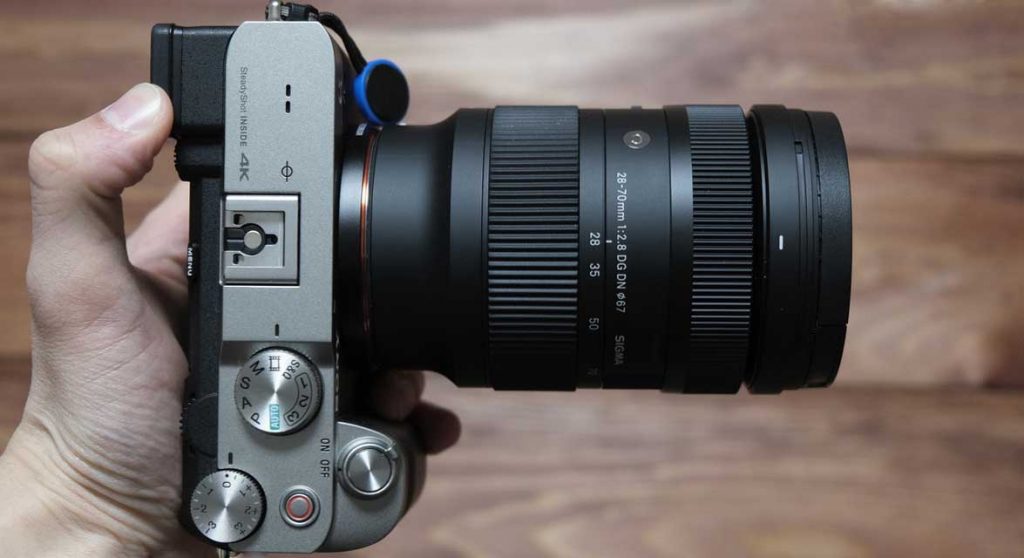
The Sigma 28-70mm f/2.8 DG DN Contemporary for Sony E mount is one of my favorite zoom lenses – for any system.
It’s a pared down version of their pro-grade Sigma 24-70mm f/2.8 DG DN Art lens.
The Sigma 28-70mm is an ambitious lens, taking the same optical design philosphy of the Sigma 24-70mm f/2.8 professional zoom, and sticking it in a significantly smaller and lighter body, while giving up the extra 4mm on the wide end.
The result is a shockingly small and light lens. It’s almost an inch smaller and a whopping 75% lighter than the Sigma 24-70mm f/2.8.
Without its hood, the Sigma 28-70mm f/2.8 DG DN is about the same size as the Sony FE 35mm f/1.8 with its petal hood attached.
With its hood, the Sigma 28-70mm f/2.8 is about the same length as the Sony Zeiss Sonnar 55m f/1.8 also with its hood attached.
If you didn’t know it yet, that is small.
This full frame constant f/2.8 lens is even smaller and lighter than the Fujifilm 16-55mm for APS-C sensors.
It’s also only slightly longer than the Olympus 12-40mm f/2.8 PRO lens, for micro-four-thirds cameras. That’s impressive, considering the Sigma is designed for full frame cameras.
It does give up some other features to its bigger Sigma 24-70mm sibling. Mainly full weather sealing (it still has a gasket on the mount though) and extra buttons (both lenses have an AF-MF switch, but the 24-70mm gains a focus lock button and a zoom lock switch).
And of course, you give up the extra 4mm on the wide end. Now, depending on what you shoot, that could be a big deal.
But, if size and weight are the primary concerns, that is a more than worthy trade off.
The Sigma 28-70mm f/2.8 balances beautifully on the Sony a7c, and is a joy to carry around all day.
Sigma is just on a roll with their lenses right now. Here is a made in Japan lens that’s small and portable, but it doesn’t sacrifice the bright aperture or optical quality.
I’ve never considered a standard f/2.8 zoom as a walk around, until this lens came along.
Highly, highly recommended.
Check the current price of the Sigma 28-70mm f/2.8 Contemporary on Amazon.
Tamron 28-75mm f/2.8 Di III VXD G2

The Tamron is a lens that doesn’t really need introduction.
The first version, the Tamron 28-75mm RXD was the world’s best selling lens for the past few years, and with good reason.
It was the first real alternative to the expensive Sony 24-70mm f/2.8 GM, and it set the tone for what to expect from third party lenses for Sony E-mount.
The G2 version is a great upgrade, featuring the newer ‘VXD’ linear AF motors (the first version had RXD motors) and a customizable button, notable for allowing you the option to customize it as a “snap” focus button – that is, you can program this button to allow you to jump to a pre-set focus distance. This is great for zone focusing, for example.
But, it’s the same formula as the mark I version of the lens – it’s relatively inexpensive, fully weather sealed and has blazing fast AF.
Compared to the Sigma 28-70mm f/2.8, it’s got that extra 5mm on the long end which may come in useful in some situations. But, personally, I wouldn’t make buying decisions based on that.
It’s slightly longer than the Sigma 28-70mm, but it weighs about the same (80g more for the Tamron).
To me, the size difference is meaningful enough that I’d prefer the Sigma, but it’s one of those YMMV things.
I will say that the size difference in real life is much bigger than in pictures.
The big advantage of the Tamron is in weather sealing. It’s got 6 seals, compared to just the o-ring on the lens mount for the Sigma.
The customizable button on the G2 version of the lens could also be a big deal – especially if you plan on using it as a “snap” focus button. If you’ve ever shot the Ricoh GR, you know how great having this feature is for street shooting.
Basically, it allows you to set the button to jump to a pre-set focus distance, even when you’re shooting in AF. This is especially useful if you’re zone focusing during street photography, for example.
The big disadvantage of the Tamron is in bokeh rendering. It’s slightly more nervous compared to the Sigma, and it shows in busy backgrounds, such as trees and buildings. Tamron has actually improved this from the V1 lens – the G2 version has decidedly better bokeh rendering than the V1, but, the Sigma 28-70mm is still slightly better in this regard.
Here’s an example of where the V1 Tamron would’ve struggled with the busy background. The G2 is much improved in this regard. But the Sigma would still render smoother.
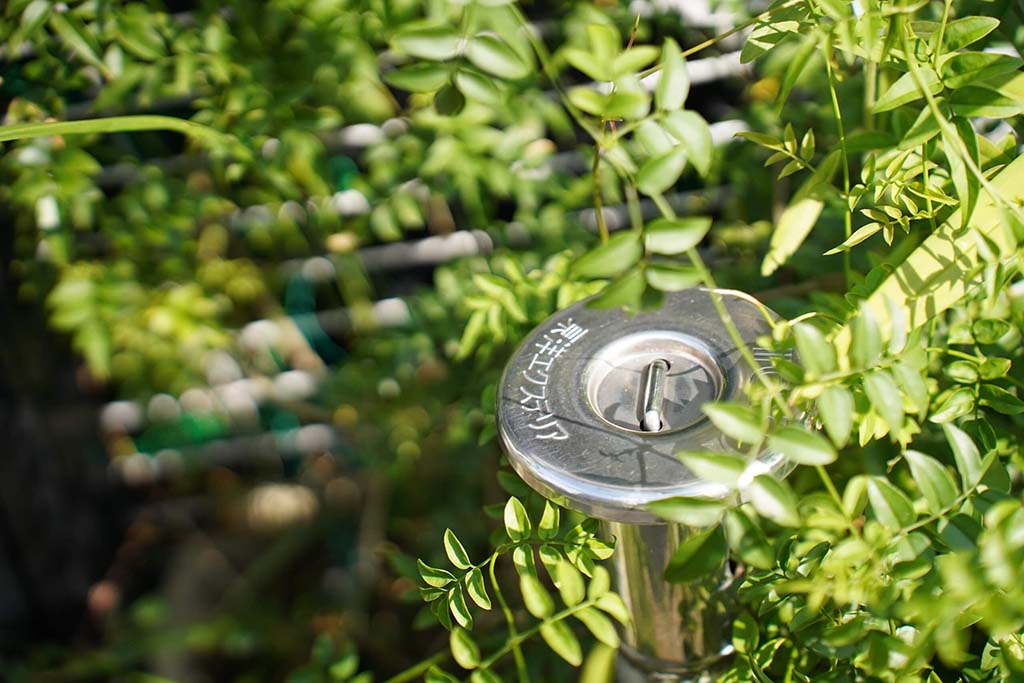
If I had to choose, I’d pick the Sigma 28-70mm f/2.8 (I did) because of the size and the smoother rendering.
But, whichever you choose, I’m pretty sure you’ll be happy. It’s one of those things where you can’t really go wrong no matter which one you choose.
Best ultrazoom lens or travel lens
Tamron 28-200mm f/2.8-5.6 Di III RXD

The Tamron 28-200mm is a unicorn.
It’s easy to dismiss it as just another super zoom. Most of us have had one before. The ultimate compromise lens.
More zoom, at the expense of optical quality. Convenience over everything else.
Well, prepare to be surprised.
The Tamron 28-200mm may very well be the best ultra-zoom lens ever made.
And, I don’t say that lightly.
It’s still a super zoom, but it’s a damn good one. If you’re pixel peeping, it won’t go toe-to-toe with a prime or a pro zoom with a shorter range.
But, optical quality is impressive. It’s sharp with minimal aberrations. Stop it down, and you’d be hard-pressed to tell the difference vs non-super zoom lenses.
It may very well be the best hiking lens for the Sony a7c.
It’s the same size as the Tamron 28-75mm f/2.8, and it shares the same 67mm filter thread as all the other Tamron f/2.8 zooms for Sony.
Impressively, the 28-200mm also manages a bright f/2.8 aperture at the wide end.
This really adds to its travel credentials, as that extra stop at 28mm can keep you from changing lenses as you go indoors.
Here is the aperture range of the Tamron 28-200mm:
f/2.8 – 28mm-30mm
f/3.2 – 31mm-42mm
f/3.5 – 43mm-53mm
f/4 – 54mm-75mm
f/4.5 – 76mm-112mm
f/5 – 113mm-146mm
f/5.6 – 147mm-200mm
Anyway you look at it, that is impressive.
That means it’s about ⅔ of a stop faster than the Sony 24-240mm f/3.5-6.3 OSS, and it almost keeps up with the Sony 24-105mm f/4 G.
Look at the aperture range changes at each focal length again. The Tamron is basically a 28-112mm f/2.8-4.5 lens, with the added bonus of going all the way to 200mm.
If you like having the ability to zoom in to 200mm in a travel or hiking lens, this is a real gem. Like the Tamron 28-75mm f/2.8, you give up the ability to get to 24mm, and you don’t have image stabilization – but you do gain that useful f/2.8 on the wide end while maintaining f/3.2 to f/4.5 from 31mm to 112mm. Impressive.
Get the Tamron 28-200mm on Amazon!
Sony 24-105mm f/4 G OSS
The other option is the Sony 24-105mm OSS. This is part of Sony’s “G” line-up. Just a step down from it’s premium “G-Master” (GM) line, but still featuring pro-grade build and optical quality.
A favorite among landscape photographers and hikers, the Sony 24-105mm f/4 covers a useful range while offering something that most 24-105mm lenses from other makers don’t – a solidly consistent optical performance throughout the entire zoom range.
Most 24-105mm lenses are optimized for one end. Either the wide end, or the long end. There are no such compromises on this lens. That is perhaps the reason that the Sony 24-105mm f/4 is the priciest 24-105mm lens on the market.
At 663 grams, it’s on the heavy end for the a7c, but, if you’re an outdoor photographer looking for a no-compromise lens, this lens will deliver.
This is for those who must absolutely have 24mm vs the 28mm on the Tamron. Or for those who want optical image stabilization. Personally, I prefer the range of the Tamron, and I don’t feel that the Tamron gives up a lot, especially factoring in the price.
Check the current price of the Sony 24-105mm f/4 G OSS on Amazon.
Best wide angle zoom lens
Tamron 17-28mm f/2.8 Di III RXD
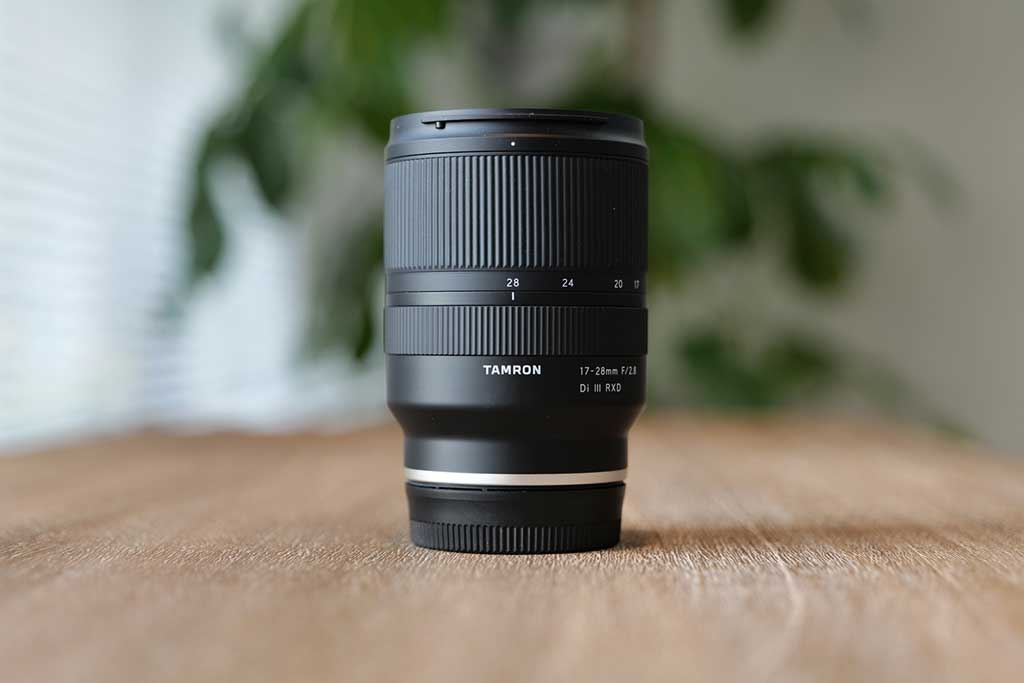
This lens was Tamron’s second f/2.8 constant zoom after the release of the 28-75mm f/2.8.
And it follows the same formula – slightly smaller zoom range, all in a small and light lens, without sacrificing the constant f/2.8 aperture or optical quality.
When paired with the Tamron 28-75mm f/2.8, these two lenses weigh a combined 970 grams. Compare that to the over 1.5 kg of the Sony 16-35mm f/2.8 GM and 24-70mm f/2.8 GM.
Both Tamron lenses also share a 67mm filter thread. The Sony combo uses 82mm filters.
And, of course, let’s not forget about price. You can get both Tamron lenses for less than the price of one of the Sony’s (either one).
Like most of Tamron’s lenses for Sony, this lens doesn’t get image stabilization, relying instead on Sony’s in-body IS.
This isn’t a big deal for a lens this wide. In fact, I am able to consistently hand-hold exposures as low as ⅕ of a second at 17mm with this lens. And I don’t have steady hands.
While it does feel more limited than a 16-35mm, the 17-28mm focal range is still a useful range. It’s great for real estate photography, astrophotography, landscapes, and because it’s small and light, it’s also a great gimbal lens.
There is a reason this lens was out of stock for a long time after its initial release. Tamron took the winning formula from the 28-75mm f/2.8, and have delivered an excellent UWA for anyone who doesn’t like the weight and size of the 16-35mm GM.
Tamron has done a great job of delivering constant f/2.8 lenses for the masses. They sacrifice a bit of zoom range, but optical quality remains top notch.
Build quality may not compare with Sony’s GM lenses, but it is still excellent, and the lenses don’t feel cheap at all. It’s made of high grade plastic composite, and is also fully weather sealed.
Here is how wide 17mm is – wide enough to fit a cramped hotel room in Tokyo 😉
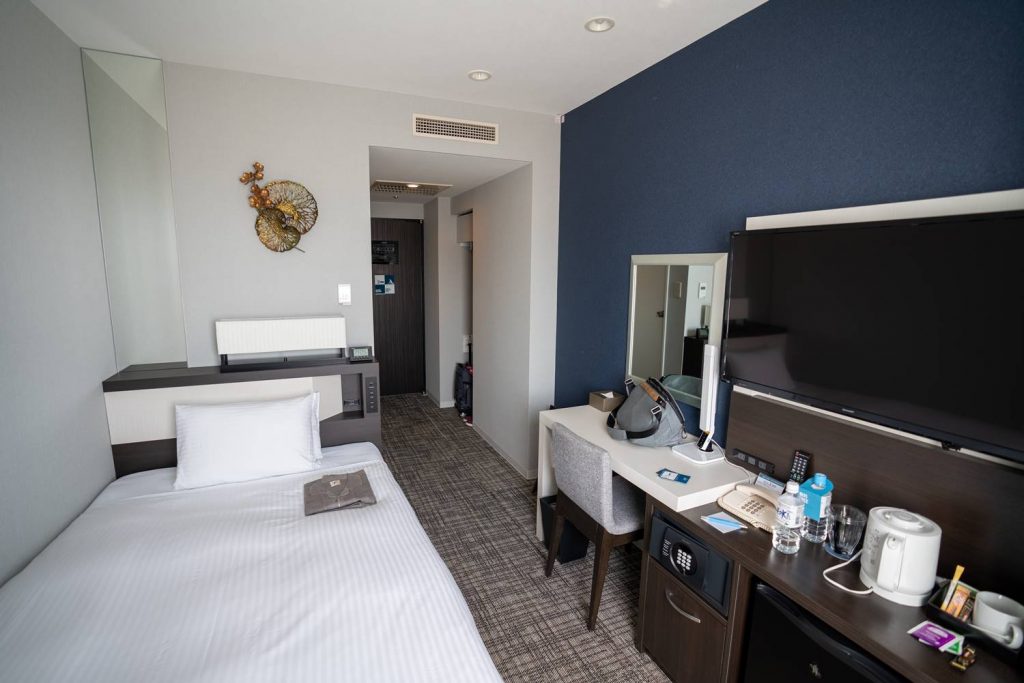
Check the price of the Tamron 17-28mm f/2.8 on Amazon.
Sony Zeiss 16-35mm f/4 OSS ZA Vario Tessar
This metal-bodied lens was the first ultra wide angle lens for Sony E mount.
Although it’s an f/4 lens, it does have image stabilization built-in the lens. It’s also roughly the same size as the Tamron 17-28mm f/2.8 above (The Sony is slightly larger and is more than 20% heavier).
The main reason to get this lens over the Tamron 17-28mm f/2.8 is the focal range. Specifically, the ability to go to 35mm, instead of 28mm.
Now, this is dependent on shooting style, and what other lenses you plan to carry with you, if at all.
Some people will find the 28mm end of the Tamron to be a bit too wide, and will strongly prefer 35mm.
For me and my style of shooting, I value the extra stop of brightness that the Tamron can provide, despite the more limited zoom range.
The Tamron is also sharper than the Sony. Not by much, and you’d need to pixel peep to see the difference. But, the Tamron does better at the corners, especially at wider apertures. This is something to keep in mind, if sharp corners are desirable all the time, such as landscape photography or real estate and interiors.
Check the price of the Sony Zeiss 16-35mm f/4 OSS on Amazon.
Best vlogging lens for Sony a7c
Sony FE 20mm f/1.8 G
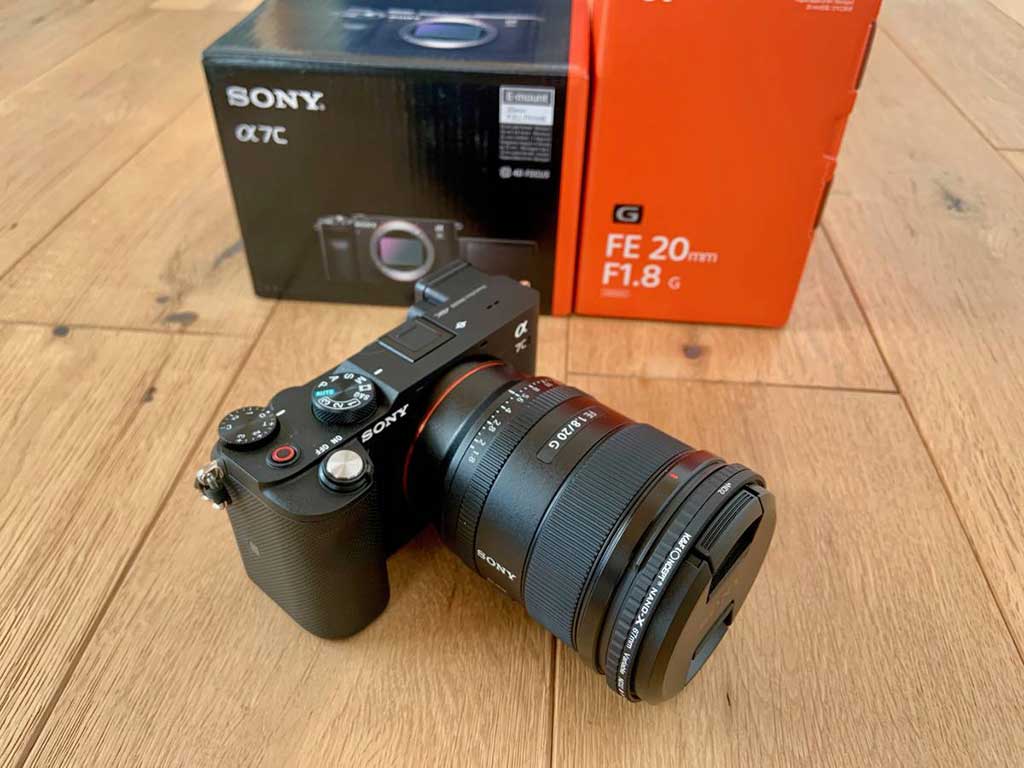
If you’re looking for the best gimbal lens, this could be it.
But, if you want something smaller and lighter, and don’t really need the f/1.8 aperture, you can check out our list of the smallest lenses for the Sony a7c and other Sony Alpha cameras.
Coming on the heels of the Sony 24mm f/1.4 GM, expectations were high for this Sony 20mm f/1.8 G lens. Nevermind that Sony did not see it fit to earn the GM moniker.
But, I think it’s safe to say that this lens has exceeded all expectations and then some. It’s really set a high bar for what to expect from a Sony G lens, especially a wide-angle lens.
While a 20mm is traditionally considered a landscape lens, or a general ‘scape lens – e.g. city scapes, night scapes, astrophotography. It has also become popular for vlogging, and general video use – e.g. real estate walk throughs, music videos etc..
Given the easy croppability of today’s high resolution sensors, fast wide-angle lenses are also desirable for their flexibility. A lot of photographers and videographers will have a hard time choosing between this and the Tamron 17-28mm f/2.8 (see above), for example.
With liberal use of APS-C crop mode (for stills) or in Super 35 mode (for video), this lens is basically like a 20mm f/1.8 PLUS a 30mm f/2.7 lens.
Now, for the a7c, this crop mode does mean you drop down to just 10 megapixels. But, for social media and web use, that’s more than enough. It’s also more than enough for a 16”x20” print.
I’m not saying you have to use it this way. But, if you’re torn between an UWA zoom like the Tamron 17-28mm or a fast prime like this one, just know that this is an option, depending on your shooting style and intended destination of your images or films.
And, if you do decide you’d rather have that f/1.8 vs the flexibility of a zoom, this is pretty much the only game in town.
While Sony shooters do have a lot of options here – such as Tamron’s own 20mm f/2.8, the tiny Samyang 18mm f/2.8, and the Zeiss Batis 18mm f/2.8, the Sony 20mm G is the only one with an aperture this bright, and with AF that can keep up with Sony’s real time tracking technology.
If you’re willing to move up to 24mm, your options do widen a bit. You’ve got the significantly more expensive Sony 24mm f/1.4 GM, the Samyang 24mm f/1.8 and the Sigma 24mm f/2 DG DN Contemporary.
But, these aren’t really competitors, in my opinion. There is a huge difference between a 20mm and a 24mm. Much bigger than the difference between 24mm and 28mm.
A 20mm will give you that extra wide angle oomph, that you simply cannot get with a 24mm. A 24mm will sometimes be indistinguishable from a 28mm, for example. But a 20mm will never be mistaken for a 28.
I’m not a big ‘scape photographer, preferring street photography and personal family documentary photography. And I do love using a 20mm for chasing kids around, much more than a 24mm.
Coupled with the bright aperture, the Sony 20mm f/1.8 G is a very fun lens to carry around. And I honestly believe that it is one that will push your creativity further than a ‘safer’ 24mm option.
Get the Sony 20mm f/1.8 G on Amazon.
Best Portrait Lens for Sony a7c
Sony FE 85mm f/1.8
As a Sony shooter, you’re spoilt for choice when it comes to portrait lenses.
The Sony FE 85mm f/1.8 is the easy recommendation, especially if you don’t want to break the bank.
The FE85 isn’t designated a “G” lens, and it doesn’t come with the bells and whistles like an aperture ring, but it does make up for it in performance.
It’s the fastest auto-focusing lens out of all 85mm choices for Sony E mount, as of today.
This is the only 85mm lens for Sony FE that I would trust to be able to grab a 100% hit rate for a child running straight at the camera, for example. The AF is that good.
And in some situations, you’ll be hard-pressed to tell images from this lens from its more celebrated f/1.4 siblings.
The low price has a lot to do with its popularity, but this isn’t one of those ‘you get what you pay for’ lenses. It really is very good. The low price just sweetens an already great deal.
It’s relatively compact and lightweight and has the best AF out of all choices in this focal length.
Especially in low light, the AF on this lens will leave the 85mm f/1.4 GM and the Sigma 85mm f/1.4 DG DN in the dust.
If you want a versatile 85mm, one that can do more than take static portraits, this is the best choice for most people.
Get the Sony 85mm f/1.8 FE on Amazon.
Sigma 85mm f/1.4 DG DN Art
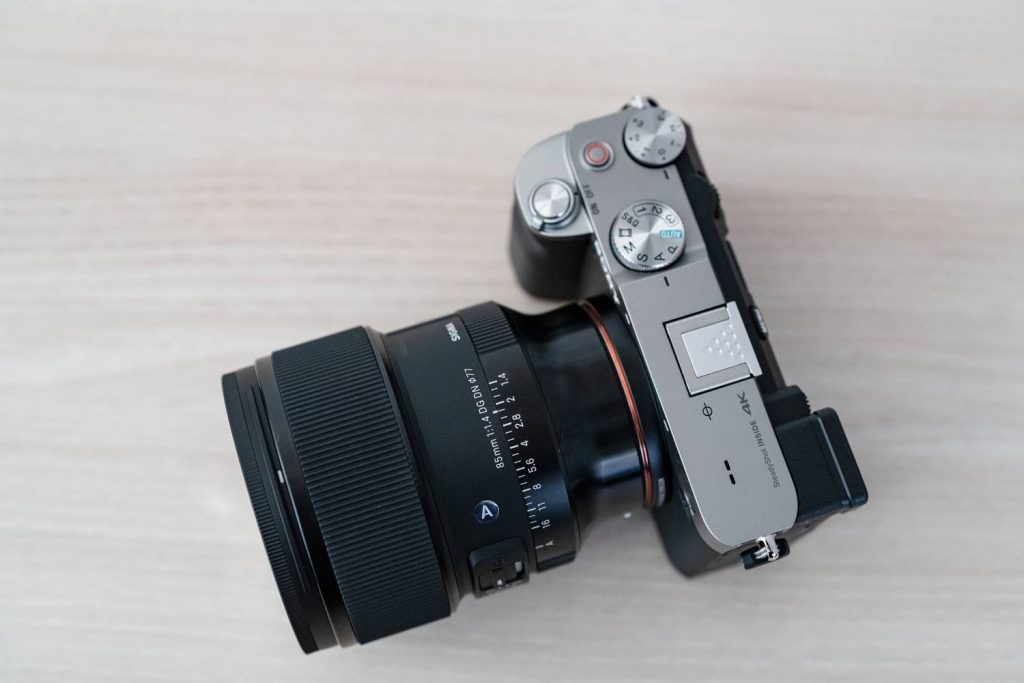
Not to be confused with Sigma’s old and humongous 85mm f/1.4 DN HSM Art lens for Sony, this newer DG DN design is designed from the ground up for mirrorless cameras.
And, boy, did Sigma pull out all the stops here.
Not only is this lens a full 1.2 inches shorter in length than the old one, it’s also more than half a kilo lighter! Wow!
This lens is almost the same size as the Sony FE 85mm f/1.8 lens.
If you really care about getting some creamy bokeh, without the bulk of a 135mm or a 50mm f/1.2 lens, the Sigma 85mm f/1.4 DG DN is the one for you.
This is the lens for the dedicated portrait shooter. Where the above Sony FE 85mm f/1.8 is for a more generalist portraitist, this one is for photographers who know for sure that they are portrait specialists.
The f/1.4 will really delivery creamy backgrounds and smooth bokeh rendering.
And it’s also got a smoothly rotating aperture ring and a dust and splash proof body.
The only downside here is that AF isn’t as good as the Sony FE 85mm f/1.8.
It’s not bad – AF on the Sigma is noticeably better than the significantly more expensive and significantly bigger Sony 85mm f/1.4 GM, for example – but it’s still designed to be a portrait lens. Eye AF is great, even in low light. But if you need to track fast moving subjects, this isn’t the lens for you.
This isn’t the lens you want to use for photographing children towards the camera, for example – the Sony FE 85mm f/1.8 will serve you better.
Check the price of the Sigma 85mm f/1.4 DG DN Art lens on Amazon.
Sony FE 55mm 55mm f/1.8 ZA Zeiss Sonnar
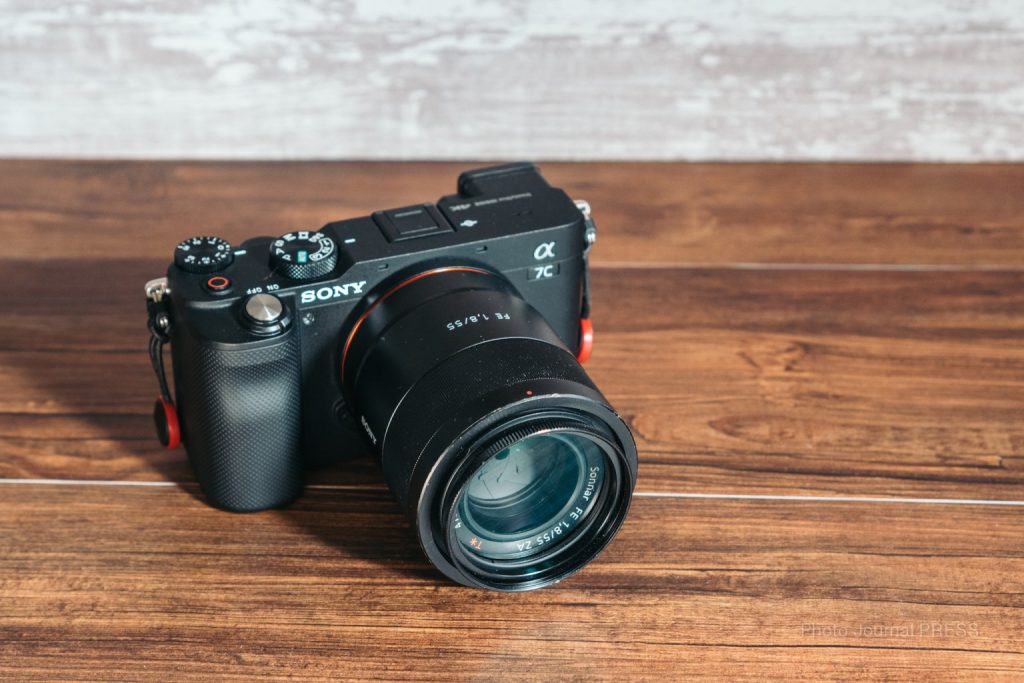
A real classic. This is one of the oldest lenses for Sony e-mount, having been announced with the original Sony a7.
And there is a reason it’s still recommended here.
It’s small and light, is bitingly sharp, and has fast, reliable AF.
It’s “only” an f/1.8 lens, but the slightly longer focal length (compared to a standard 50mm lens) will help you get more subject isolation.
Background blur is not that different vs the Sigma 65mm f/2, for example.
While I personally prefer an 85mm for portraits, there are times where you just won’t have the space to back-up for a full body portrait, for example.
Or, there are times where you just want one lens that can work as a general walk-around lens and as a portrait lens.
This is where a standard focal length like the 55mm comes in.
While you’re spoilt for choice in this focal range, the Sony 55mm is the perfect balance of size, weight, optical quality and AF performance. Perfect for the a7c.
Check the current price of the Sony Zeiss 55mm f/1.8 on Amazon.
Best Telephoto Lens for Sony a7c
Tamron 70-180mm f/2.8 Di III VXD
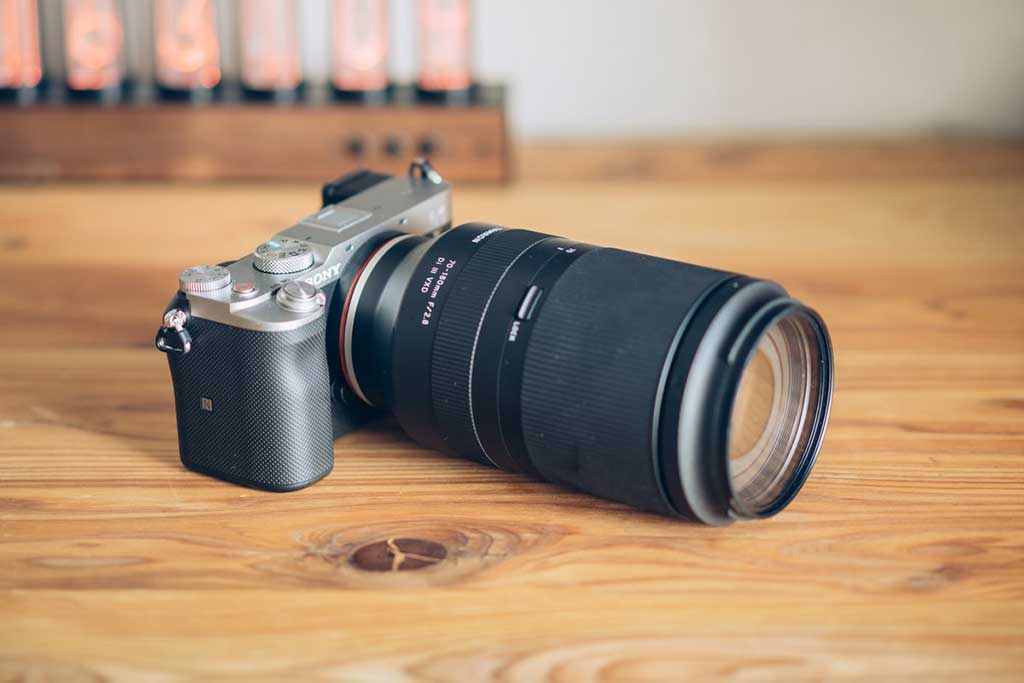
The 70-180mm f/2.8 completes Tamron’s trinity of ‘budget’ f/2.8 zooms for Sony E mount. After the considerable success of the Tamron 28-75mm and 17-28mm, they have now rounded out the trinity with their most ambitious lens yet.
There is just no way around it – a constant f/2.8 telephoto zoom lens is going to be big. That’s just physics.
The Tamron 70-180mm f/2.8 lens isn’t a small lens by any means – but it is small for what it is.
And what it is is a high quality, constant f/2.8 telephoto lens with all the right compromises.
You don’t really have a lot of choices for a fast, telephoto zoom.
For Sony E-mount, your choices are:
- Sony FE 70-200mm f/2.8 GM – $2600
That’s it.
After that, you’ve got the Sony 70-200mm f/4. But that’s an f/4 lens and it still costs more than this Tamron.
Not to mention, both Sony lenses also come in white lens bodies. Personally, I’m not a fan, as I prefer the more inconspicuous black colored lenses.
Tamron did have to make a few trade-offs to get a constant f/2.8 telephoto lens at this size and price.
The most glaring omission is a lack of optical image stabilization. Both Sony lenses have them. And while almost all Sony bodies, including the a7c, feature in-body image stabilization, optical lens stabilization is preferred for longer focal lengths.
So, is this a big deal? It depends on what you’re using it for.
For my purposes, I’m mostly using this lens for portraits of my kids and for catching unguarded moments. That means I’m mostly shooting at higher shutter speeds, where the benefits of optical image stabilization are not really needed. In this case, the in body image stabilization does a more than adequate job.
My other use for this lens is as an urban landscape lens – for zooming in to little details, like light bouncing off a building; steam rising out of buildings during winter etc… – in these cases, lens stabilization would come in useful – but it’s a trade off I’m willing to make. I’d rather have a more portable lens vs a bigger lens with stabilization built-in.
The other concession that Tamron had to make was to shave off 20mm from the long end. Personally, this is a non-issue for me. Sure, in side-by-side comparisons with a 70-200mm f/2.8, that extra 20mm will add more background blur for you. But, in real world use, 180mm at f/2.8 is more than enough to get subject isolation. You will not miss it, most of the time.
Tamron hit the sweet spot here. This lens is priced well, delivers excellent images, and the VXD AF motors work just as well as Sony’s linear motors.
This isn’t a small lens – it will be front heavy and clunky on a small body like the a7c. But, it’s the smallest f/2.8 telephoto zoom for full frame cameras right now. And, as of today, it’s only available for Sony mount.
Check the price of the Tamron 70-180mm f/2.8 VXD on Amazon.
Tamron 70-300mm f/4.5-6.3 Di III RXD
The Tamron 70-300mm is the smallest and lightest 70-300mm lens you can get for full frame cameras.
It’s also pretty inexpensive.
Its relatively slow aperture makes it a daylight lens – but its range from mid-telephoto all the way to 300mm is useful for a wide variety of subjects.
It can be a great portrait lens, a wildlife lens, a candid street photography lens. It’s great even for photographing birds in your backyard. Basically, it’s a fantastic outdoor sports or active lens – on the streets, on the beach, at the park etc…
Want a lens for an airshow without breaking the bank? This is the lens for you.
Paired with the a7c’s real time tracking AF, you will likely have a better hit rate than more expensive set-ups from other camera brands that don’t have Sony’s AF prowess.
Just like the 70-180mm f/2.8 above, Tamron decided against adding optical image stabilization on this lens, choosing instead to go with the in-body image stabilization found in most Sony cameras, including the a7c.
It’s only 3 inches long, when stowed with the hood reversed. That’s a full 2.5 inches shorter than the Sony 70-300mm OSS f/4.5-5.6 G lens. And it weighs a mere 545 grams, that’s more than 250 grams lighter than the Sony.
Although this lens doesn’t get the VXD AF motors of the Tamron 70-180mm, it does get the same RXD motors as the Tamron 28-75mm f/2.8 and 17-28mm f/2.8, which is no slouch. Eye AF works amazingly well, and as long as you have enough light, it will grab focus and track very well in most situations.
Tamron has come up with a great lens here, despite the aggressive price point. If you’ve used the budget 70-300mm lenses from DSLR’s, you will be pleasantly surprised by what you’ll find here. It’s a clear step up from the budget 70-300 lenses of old. Two steps up, even.
The big downside here is the slow aperture, making this a strictly daylight lens. This won’t cut it even for a decently lit night football game.
If you want a bit of reach, but don’t really need to go all the way to 300mm, do consider the Tamron 28-200mm (also discussed above), which is a better performer optically. And, it’s also a much more useful focal range.
Check the price of the Tamron 70-300mm for Sony on Amazon.
Check the price of the Tamron 70-300mm on Amazon
Best Macro Lens for Sony a7c
Sigma 105mm f/2.8 DG DN Macro ART
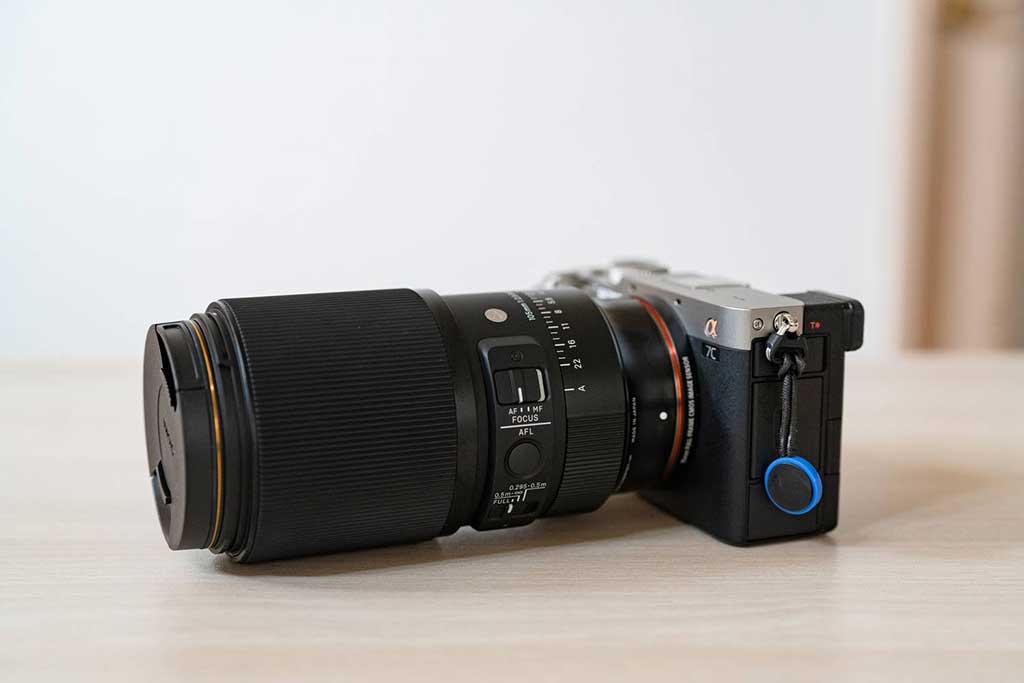
If you’re serious about macro photography, this is the one you want. Be warned though, it’s a hefty 710 grams, and is front heavy on the a7c.
But it’s a serious piece of kit, and can do double duty as a mid-telephoto, great for impromptu portraits or photographing other non-macro details.
It is capable of 1:1 macro reproduction (life size), with a minimum focusing distance of 11.6 inches or 29.5 centimeters.
It has dust and splash resistance, including a fluorine coating on the front element. This coating helps in repealing liquids, and will allow you to easily wipe off splashes to the front element (no smudges!).
There is a nice and clicky aperture ring, a focus hold button, an AF/MF switch and to help speed up AF in non-macro situations – a focus limiter switch.
As expected from Sigma’s ART series, the optics are top notch. As good as, if not better than the Sony 90mm f/2.8 G Macro, which costs more.
The Sigma is a great general purpose macro lens. 105mm is long enough to give you good working distance from subjects that may scurry away (e.g. insects) but it’s still close enough to use in the studio for product photography.
And, if you’re not shooting macro, and want to use it as a portrait lens for example, the longer 105mm focal length will help with subject isolation. But, it’s not too long that you will feel disconnected from your subject.
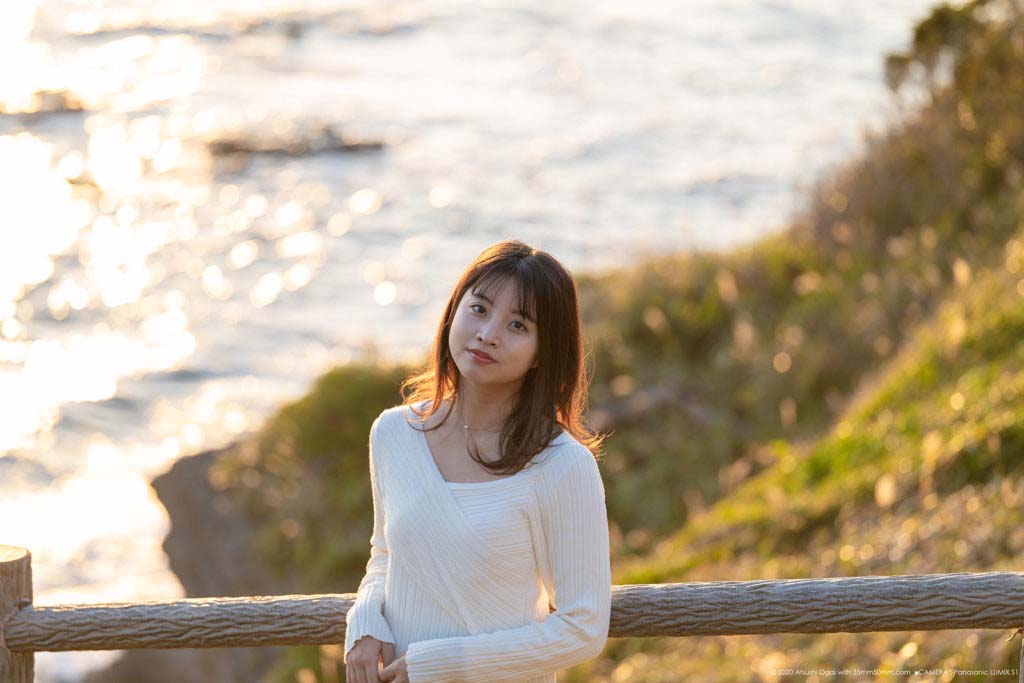
The only advantage the Sony 90mm f/2.8 Macro has over the Sigma is the addition of OSS. But, since most macro shooting is done on a tripod, I wouldn’t pay hundreds more for the Sony. Plus, the extra reach is really useful, whether in macro shooting or in non-macro shooting.
The Sigma is an excellent value, and is hands down the best macro lens for Sony full frame. There really aren’t any negatives here. And the fact that it costs less than the Sony 90mm just makes it a crazy good deal.
Get the Sigma 105mm macro for Sony E-mount on Amazon.
CompactShooter.com is a participant in the Amazon Services LLC Associates Program, an affiliate advertising program designed to provide a means for sites to earn advertising fees by advertising and linking to Amazon.com. This means that we get a small commission on products sold through affiliate links at no extra cost to you.
Would you recommend the Sony 35mm 1.8 or Sigma 35mm f2 as your “everyday lens”? For shooting family, street shots etc.
I know you put the Sony lens higher for exclusively street but I was wondering for the everyday carry style lens.
out of all these recommended lenses, which one would be the best option for someone who wants to photograph a jiu-jitsu fight? Would wide-angle zoom lenses be a good option?
i know that post was written well before Sony 24-50 G 2.8 arrived but have you had a chance to try it? I am hesitating between this one, sigma/tamron 28-75 2.8 or tamron 28-200 (which is actually my strongest candidate). I want to pair it with sony 7cr for travel/hiking/family. Sony is more like a pack of primes in one body, the others more like zooms. still not sure… any advise?